Viewpoint by Tania Kovats a concrete sculpture from 1998 located beside Keilder Water in Northumberland
image via Geograph
public sculpture
Viewpoint by Tania Kovats a concrete sculpture from 1998 located beside Keilder Water in Northumberland
image via Geograph
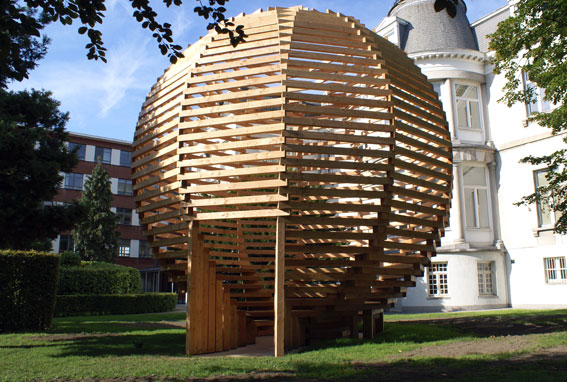 Untitled #151, Douglas Fir, 800cm x 800cm x 800cm, 2010
Untitled #151, Douglas Fir, 800cm x 800cm x 800cm, 2010
Andreas Wilder makes large sculptures by stacking lengths of timber. Many of these are temporary and as the projects end they are knocked down like dominoes.
More about Aeneas Wilder's work
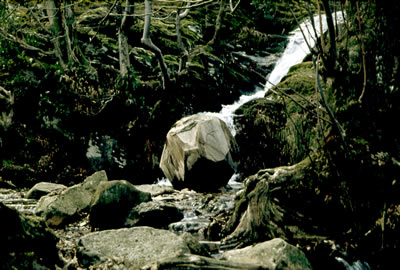
"He (David Nash) first carved a rough sphere... and intended to take this back to his studio. However, access was up a long steep track and at 400 kg and a metre wide, this 'boulder' was dangerous to move downhill. So instead Nash used a nearby stream, where rocky banks would contain the momentum of its descent.
However, a little way down the bank, the boulder became wedged in a waterfall. Nash had no option but to leave it there. It looked good in the streaming water, and so Nash began photographing it... the journey of Wooden Boulder had begun.
The following March heavy rainfall shifted Wooden Boulder into the pool below. Still with the intention of moving it to his studio, Nash hauled it out of the stream and rolled it down the next waterfall to the pool below, where it remained for eight years. It became obvious that the Wooden Boulder belonged to the stream; over the next 24 years it moved nine times during storms, eventually floating into the River Dwyryd estuary. Nash says of Wooden Boulder, 'It is important to the narrative of this "free-range"; sculpture that its material formed and grew on the hill over two centuries. I did not take the wood up the hill. The narrative, like the material, grew organically.'
Text quoted from the Kew Gardens website
Here is a video of Nash talking about Wooden Boulder and another work
The Jellyfish theatre is constructed entirely from recycled materials including pallets and water cooler containers.Its a project by artist and architect Martin Kaltwasse and Folke Kobberling in collaboration with the Red Room film and theatre company.
There's more info at Oikosproject.com and an article on the Guardian's website here.
 More proposals and info here
More proposals and info here
 Here's a video documenting the production of Tania Kovats' artwork Tree made for the Natural History Museum in London.
Here's a video documenting the production of Tania Kovats' artwork Tree made for the Natural History Museum in London.
The artwork is a slice cut from the centre of a real oak tree and was inspired by the work of Charles Darwin.
There's an article in today's Irish Times about Katie Holten's Tree Museum and her upcoming show at the Hugh Lane as a part of the Golden Bough series. The Tree Museum was a public artwork that examined people's relationships to trees in the Bronx area of New York through an audio guide featuring recordings of local people. Below is a short video about the Tree Museum and the audio recordings are available through her website.
The video above features a sculpture of a fullstop by Fiona Banner in London. It comes from The Centre of Attention's youtube channel.
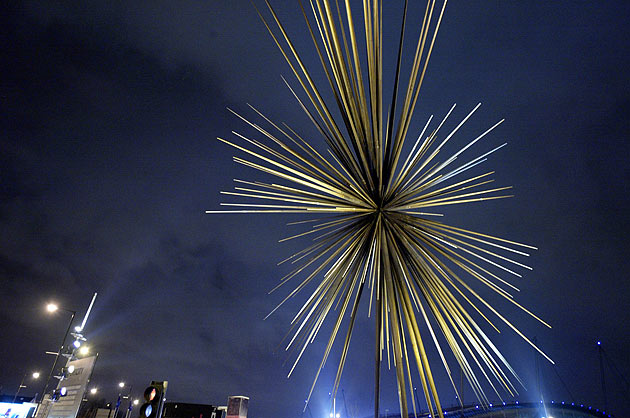
There were two stories in the news today about high profile public sculptures in the UK. It was announced that Mark Wallinger's proposal to build a giant horse in Kent has been selected for the "Angel of the South" project and will be built pending Councillors' approval. My views on his proposal are aired in this earlier post.
It was also announced that the pictured sculpture "B of the Big Bang" by the Thomas Heatherwick Studio in Manchester is to be dismantled. Here is some info from the Guardian:
A week before its unveiling the tip of one of its spikes fell to the ground. In May 2006, nine more spikes were removed for safety tests amid fears that the sculpture, designed by Thomas Heatherwick, might pose a risk to passersby.
In November last year, the Thomas Heatherwick Studio agreed to pay Manchester city council £1.7m in an out-of-court settlement over the safety problems. The council's executive committee decided today that the sculpture should be dismantled, citing "technical problems".
More http://www.guardian.co.uk/artanddesign/2009/feb/11/b-bang-sculpture-manchester

The paraSITE project by Michael Rakowitz involves "Custom built inflatable shelters designed for homeless people that attach to the exterior outtake vents of a building’s Heating, Ventilation, and Air Conditioning (HVAC) system. The warm air leaving the building simultaneously inflates and heats the double membrane structure. Built and distributed to over 30 homeless people in Boston and Cambridge, MA and New York City."
Arts managment Ireland has a post about the Antony Gormley sculpture which is planned for the Dublin Docklands:
On the 16th of January the Irish Times ran a story announcing the approval of planning permission for the work by Dublin City Council, only to be followed the next day with news of the project being scrapped due to budget reasons.
Yesterday’s Sunday Times has refuted the refutation, quoting the sculptor and DDDA arts manager Mary McCarthy as stating the project is still ‘full steam ahead’.
http://artsmanagement.ie/2009/01/26/as-clear-as-the-waters-of-the-liffey/
The five proposals for The Ebbsfleet Landmark sculpture (nicknamed "the Angel of the South") have been cut down to three. The remaining proposals are Mark Wallinger's giant horse, Richard Deacon's construction of triangles, and Daniel Burren's tower. The whole commision seems absurd to me the commisioners seem to think they can recreate the success of Antony Gormley's Angel of the North by commisioning an even bigger artwork. They are forcing artists to work on a scale that is completly inappropriate and which, I believe, will result in a terrible piece of sculpture. I think the project will be a failure, the best that can be hoped for is damage limitation. A dry, conceptualist like Daniel Burren was unlikely from the beginning to produce a work that the public would respond to in the way they have The Angel of the North. I am sure his piece will not be built - it's strange that he was even asked to make a proposal.
Richard Deacon is one of the top contemporary sculptors in the world today and he is the only artist on this shortlist who can truthfully be referred to as a sculptor. His proposal for the "Landmark" is far from his best work, though I think it is the best of the five original proposals. I don't think the public would warm to the work and it would probably be ridiculed by as just a pile of sticks.
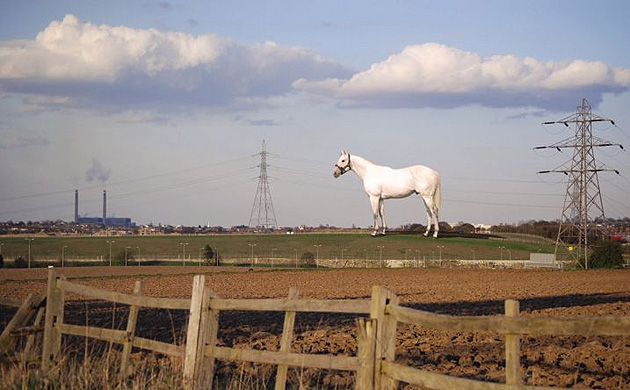
Wallinger has proposed a sculpture of a giant horse. The computer generated visualisation of the piece in situ looks like a photograph of a real horse photoshopped onto the site. The work will be actually be coloured to look exactly like a real horse! This proposal is the only one that I think has the potential to become a landmark and to be well recieved by the general public. I think Wallinger is going to win but I also think this horse will be one of the worst piece's of sculpture ever produced. I think this is the laziest proposal of the whole lot and the lack of effort it displays is charactertistic of Mark Wallinger's work since winning the Turner Prize. He has too many opportunities to create ambitious works and has the resources made available to carry them out too easily. The demand for the artist and the ease with which he now can realise these ambitious projects seems to have resulted in a lack of real work, a lack of the struggle that is at the core of any artist's creative process, and a lack of vitality in recent works such as his contribution to the Folkestone triennial.
The horse is a five second idea. If you took to the streets and asked people at random what kind of sculpture they would like to see I'll bet a horse would be one of the top five responses. It seems to me to be an idea that the artist has just thought up rather than arrived at through a creative, sculptural process.
Wallinger does not have enough experience of large scale sculpture to successfully undertaking a commission of such extraordinary scale. Few, if any, artists actually do. The potential for failure is a large part of any artists process. Any artist produces a certain amount of crap work which never sees the light of day. Once work begins on this sculpture there is no going back. The desctruction of the work is not an option. When producing work on a momentous scale there is the potential for momentous failure.
Wallinger is out of his depth. He is an artist who dabbles in a range of media one of whic is sculpture. There is no room for dabblers when commisioning a sculpture of this scale and expense. I'm convinced they will commission Wallinger's piece and in do doing so they will get their "Landmark" and they will get their stories in the press. What they won't get is an excellent piece of public art and this is ultimately the fault of the commissioners. They created a ridiculous brief in an attempt to imitate the success (in terms of popularity and iconic status) of the Angel of the North the extent of which could not have been planned or predicted by either the artist or the commisioners.
Eusebio Sempere, a respected minimalist 20th century Spanish artist, created a sculpture composed of a three-dimensional array of polished stainless-steel tubes that rotates at its base.
In addition to its provocative visual effect as the moving surfaces reflect in the sunlight, it was also a sonic filter that blocked transmission of particular frequencies. A listener on one side heard a tonal modification of those sound sources located on the other side, the visual equivalent of colored glass prisms. This sculpture is an aural embellishment because it changes sounds that propagate through it.
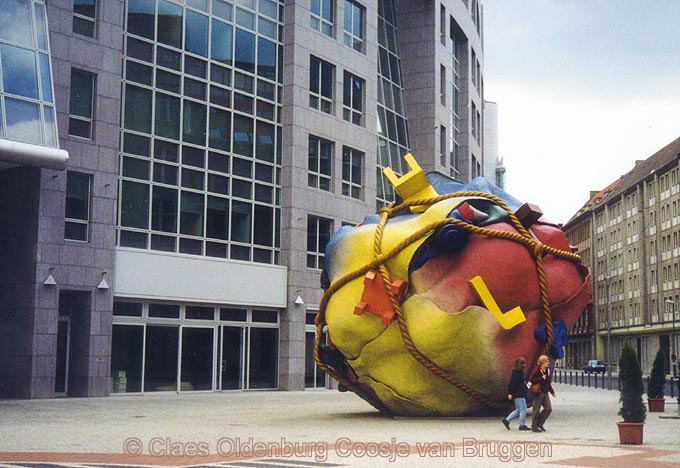
Pictured above is a public sculpture by located at Claes Oldenburg and Coesje van Bruggens Bethlehemkirch-Platz, Mauerstrasse, Berlin. I think this is possibly the worst piece of public sculpture I have every seen. It's definitely the worst I've seen by an artist who has done work that I like.
I admire much of Oldenburg's early work particularly the "ghost versions" of his soft sculptures two of which are pictured below.
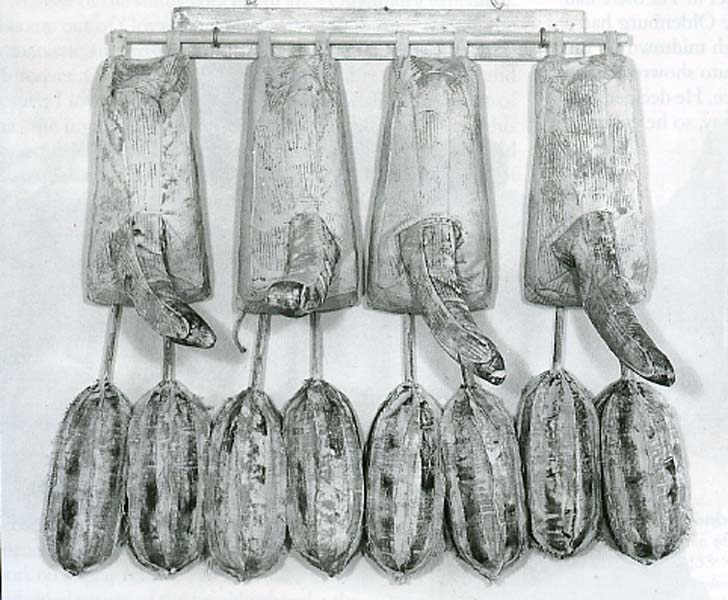
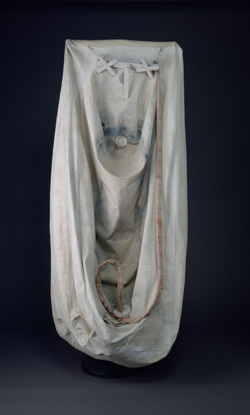
For me he has always been the most interesting of the artist's associated with Pop Art. He has always shown an insightful and original approach to the development of scuptural forms and his early work has a viscerality and suggestive power absent in the vacuous work of many of his contemporaries such as Roy Lichtenstein.
Oldenburg has been making these large public works with his partner Coosje van Bruggen. With some of the large scale projects they have experimented and produced some genuinely interesting pieces such as Bat Column (1977) and Bottle of Notes (1993). Both are pictured below.
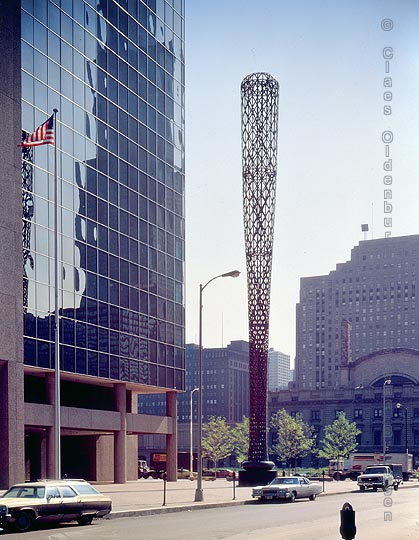
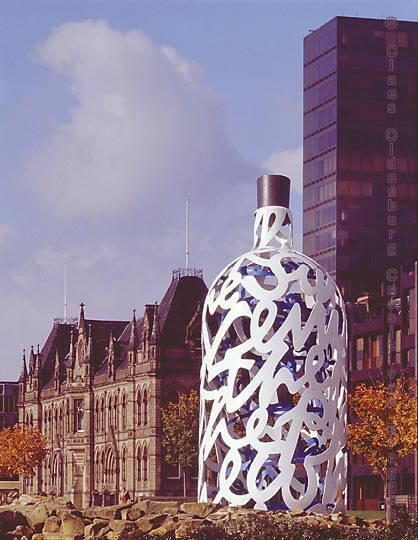
However more often than not their public sculptures are formulaic, tacky, enlarged objects plonked down on a street, park or building. These works are as vacuous as the worst examples of pop art and at there worst are ugly and seem out of place. Below is a sculpture called Dropped Cone designed to look as though it has fallen from the sky!
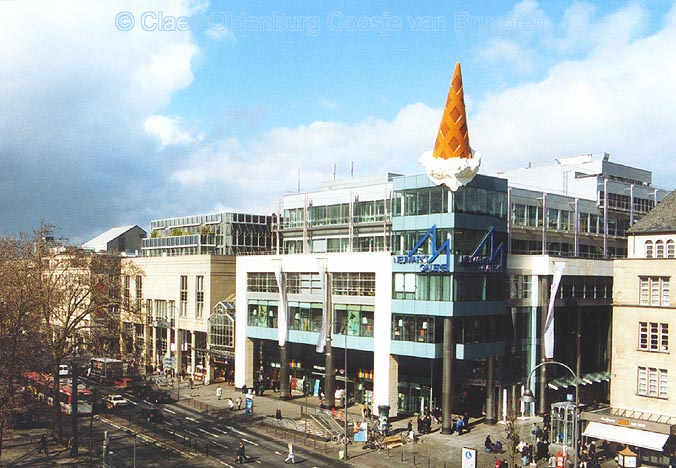
http://www.oldenburgvanbruggen.com
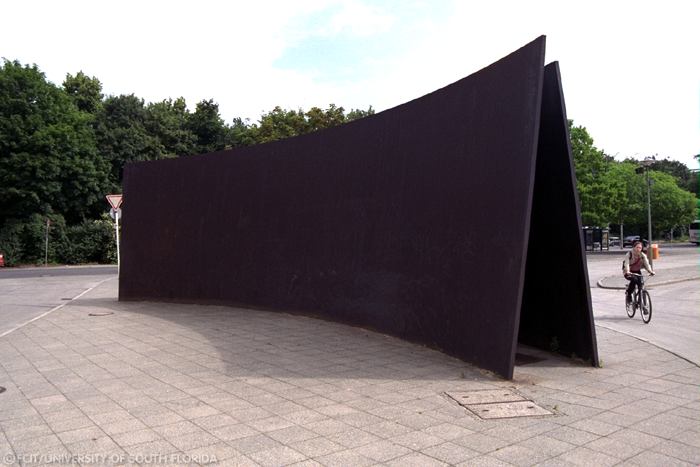
I have seen two Richard Serran sculptures at the Kulturforum. There is a slanted block dedicated to Charlie Chaplin at the Neunational Gallerie and the piece pictured above is outside the Philharmonic. Unfortunately this piece has been vandalised - there is some graffiti on the inside and numerous spots where it can clearly be seen that graffiti has been removed. I'm a big fan of Serra but the vandalism of his public works seems to be a big issue. Below is a quote from the NY Times about the public's response to a Serra sculpture in Paris.
“Clara-Clara” is back in the Tuileries, at least until November. But much to Mr. Serra’s chagrin, those who visit it, on dusty ground, have decided in a kind of collective fancy to put their footprints on the steel.
The soles of sneakers and athletic shoes may have their own formal design, but the prints look tacky on the orangey patina of the steel. As much as one may admire the dexterity of those who have put their footprints high up on the sculpture, Mr. Serra is not pleased at the way these particular viewers have chosen to “implicate” themselves and “apprehend the space and the piece.”
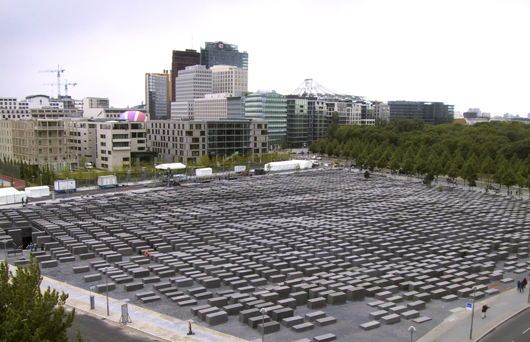
I am also a fan of the Holocaust Memorial in Berlin (above) which consists of 2,700 concrete slabs and was designed by Peter Eisenman.
Update: I've just read recently that Serra was involved in the conception of the Holocaust Memorial but quit the project as he felt there were too many compromises being made - there was a reduction in the number of slabs from 4,100 to 2,750 and they were forced to place trees around the edges.
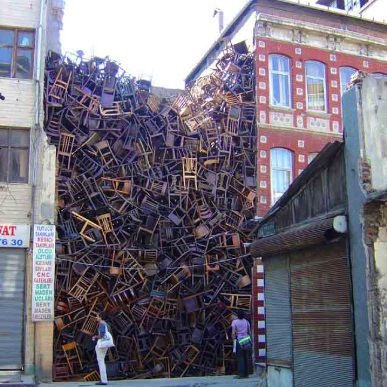
Doris Salcedo via wooster collective